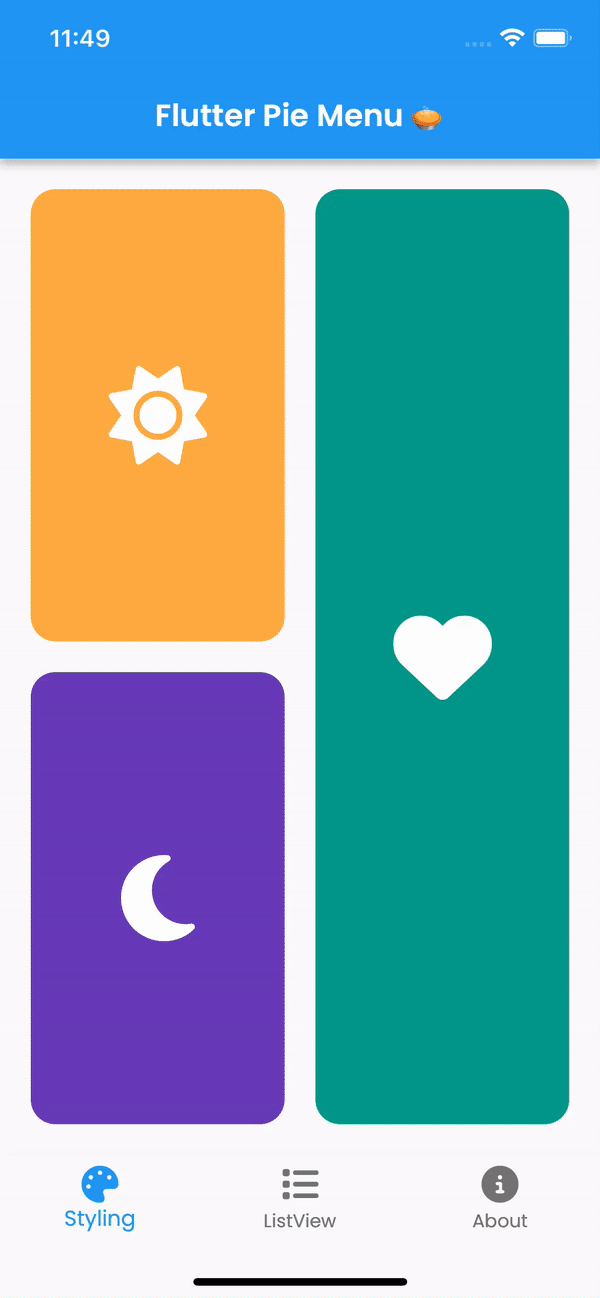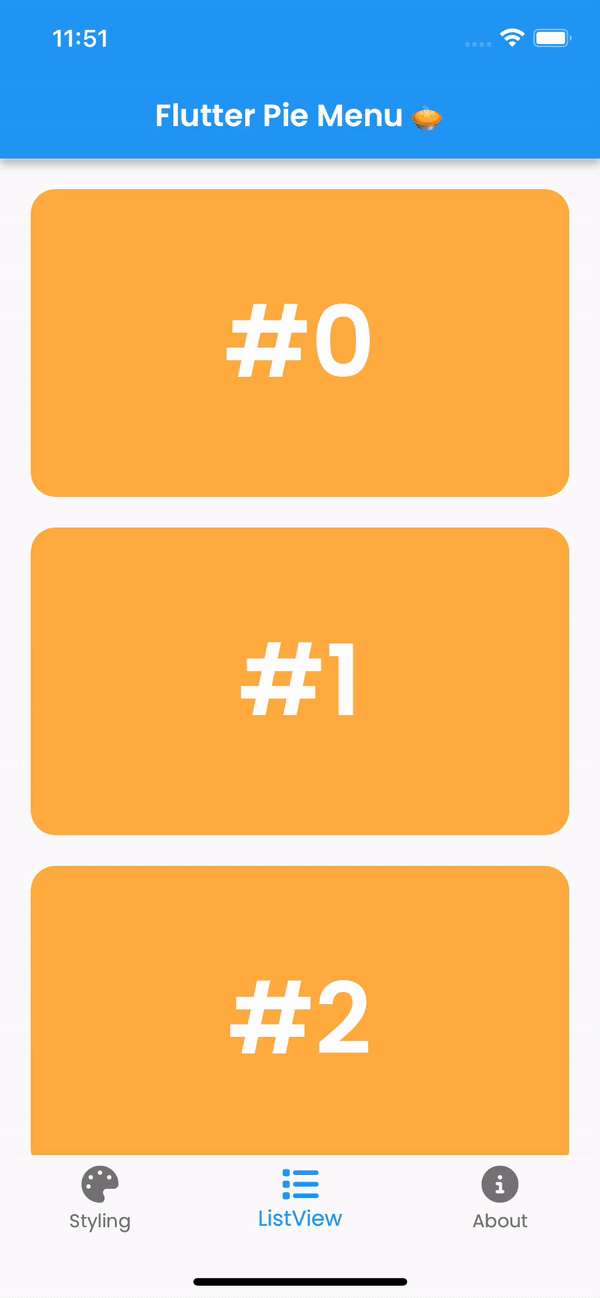Flutter Pie Menu 🥧
A Flutter package providing a highly customizable circular/radial context menu, similar to Pinterest's.
Click here to try Flutter Pie Menu online!
 |
 |
 |
|---|
Table of Contents
Usage
Wrap the widget that should respond to gestures with the PieMenu widget, and provide the menu with an array of PieActions to display as circular buttons.
PieMenu(
onPressed: () => print('pressed'),
actions: [
PieAction(
tooltip: const Text('like'),
onSelect: () => print('liked'),
child: const Icon(Icons.favorite), // Can be any widget
),
],
child: ChildWidget(),
),
💡 Don't forget that you can only use
PieMenuas a descendant of aPieCanvaswidget.
Wrap your page, or any other desired widget for drawing the menu and the background overlay, with PieCanvas widget.
For instance, if you want the menu to be displayed at the forefront, wrap your Scaffold with a PieCanvas like following:
PieCanvas(
child: Scaffold(
body: YourScaffoldBody(
...
PieMenu(),
...
),
),
),
💡 You can utilize the
onPressedcallback defined inPieMenuto manage tap events without the need for an extra widget such asGestureDetector.
Customization
You can customize the appearance and behavior of menus using PieTheme.
Using the theme attribute of PieCanvas widget, you can specify a theme for all the descendant PieMenu widgets.
PieCanvas(
theme: PieTheme(),
...
PieMenu(), // Uses the canvas theme
...
PieMenu(), // Uses the canvas theme
...
),
But if you want to specify menu specific themes, you can also use the theme attribute of PieMenu widget.
PieMenu(
theme: PieTheme(), // Overrides the canvas theme
),
It is also possible to copy the canvas theme with additional parameters, but make sure you are accessing it with the right context.
PieMenu(
theme: PieTheme.of(context).copyWith(
...
),
),
Button themes
Buttons' background and icon colors are defined by theme's buttonTheme and buttonThemeHovered. You can create a custom PieButtonTheme instances for your canvas and menu themes.
PieTheme(
buttonTheme: PieButtonTheme(),
buttonThemeHovered: PieButtonTheme(),
),
You can even give the buttons custom styles using decoration property of PieButtonTheme.
PieButtonTheme(
decoration: BoxDecoration(),
),
Custom button widgets
If you wish to use custom widgets inside buttons instead of just icons, it is recommended to use PieAction.builder() with a builder which provides whether the action is hovered or not as a parameter.
PieAction.builder(
tooltip: const Text('like'),
onSelect: () => print('liked'),
builder: (hovered) {
return Text(
'<3',
style: TextStyle(
color: hovered ? Colors.green : Colors.red,
),
);
},
),
Display angle of menu buttons
If you don't want the dynamic angle calculation and have the menu appear at a fixed angle, set customAngle and customAngleAnchor attributes of PieTheme.
PieTheme(
customAngle: 90, // In degrees
customAngleAnchor: PieAnchor.center, // start, center, end
),
You can also use customAngleDiff or spacing to adjust the angle between buttons, and angleOffset to rotate the menu.
Specific menu position
Use menuAlignment attribute of PieTheme to make the menu appear at a specific position regardless of the pressed point. Combine it with menuDisplacement to fine-tune the position.
PieTheme(
menuAlignment: Alignment.center,
menuDisplacement: Offset(0, 0),
),
Tap, long press or right click to open the menu
Set delayDuration of your theme to Duration.zero to open the menu instantly on tap.
PieTheme(
delayDuration: Duration.zero,
),
Using rightClickShowsMenu and leftClickShowsMenu attributes of PieTheme, you can customize the mouse button behavior.
PieTheme(
rightClickShowsMenu: true,
leftClickShowsMenu: false,
),
Controllers and callbacks
To open, close or toggle a menu programmatically, assign a PieMenuController to it.
// Create a controller inside a stateful widget.
final _pieMenuController = PieMenuController();
// Assign the controller to a PieMenu.
PieMenu(
controller: _pieMenuController,
...
),
// Control the menu using the controller.
_pieMenuController.open(
menuAlignment: Alignment.center,
);
If you need to do something when the menu is toggled, use onToggle callback of PieMenu, or onMenuToggle callback of PieCanvas.
PieMenu(
onToggle: (menuOpen) => print('Menu ${menuOpen ? 'opened' : 'closed'}'),
...
),
PieCanvas(
onMenuToggle: (menuOpen) => print('A menu ${menuOpen ? 'opened' : 'closed'}'),
...
),
Contributing
Pull requests are welcome. For major changes, please open an issue first to discuss what you would like to change.
Donation
If you find this package useful, please consider donating to support the project.





